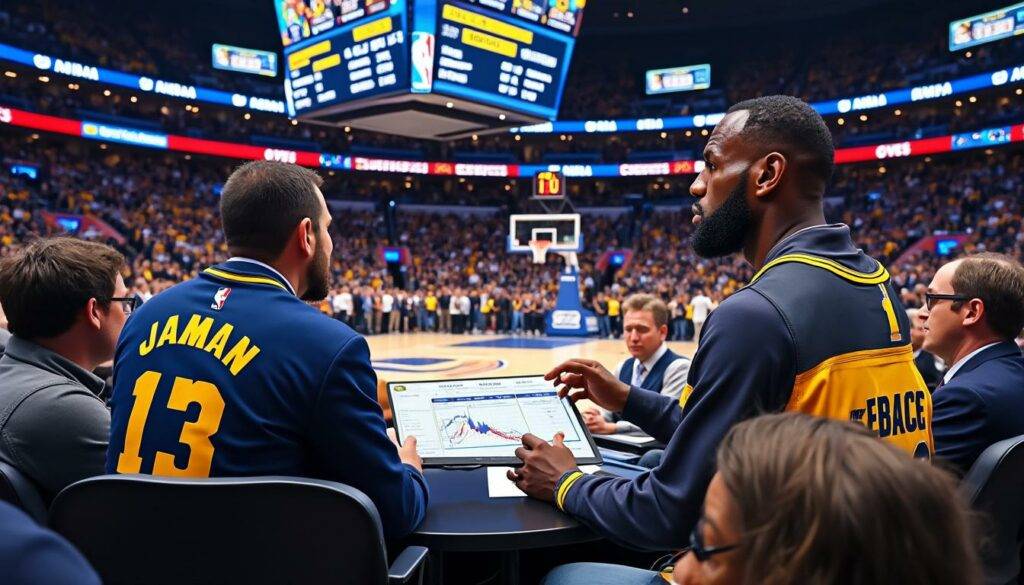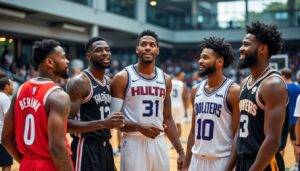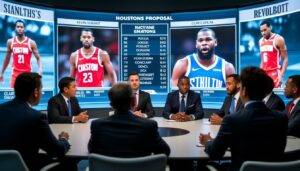Exploring LeBron's ultimate strategy in NBA free agency and assessing Denver's resurgence

NBA free agency in 2025 has kicked off with a peculiar dynamic: LeBron James, the league’s most influential figure, remains a linchpin not by actively hunting new contracts but by choosing stability over uncertainty. The Los Angeles Lakers’ cautious moves, highlighted by their eventual signing of Deandre Ayton, shed new light on the challenges this franchise faces amid salary caps and roster constraints. Meanwhile, the Denver Nuggets have seized the moment, executing savvy trades and acquisitions to bolster their championship aspirations. This is a tale of contrasting strategies — a reminder that while star power commands headlines, smart team-building is equally vital in today’s NBA landscape dominated by complex salary systems and evolving player markets.
LeBron's Free Agency Strategy: Stability Over Chaos in 2025 NBA Offseason
LeBron James’ decision not to enter free agency by opting into the final year of his contract with the Lakers has been the shockwave of the early offseason. His choice preserves his no-trade clause, keeping maximum control over his destiny but sparking rampant speculation. Lakers insiders have painted a picture of frustration and strategic ambivalence around acquiring key pieces, especially the long-coveted center position.
- Priority Signing: The Lakers prioritized Jake LaRavia, winning a quiet bidding war among several teams, signaling their intent to build young talent around LeBron.
- Center Market Challenge: With coveted players like Brook Lopez and Clint Capela snapped up early, and a pricey ask for Mark Williams (a young player plus unprotected future picks), L.A. found themselves starved at center.
- Reviving with Deandre Ayton: Ultimately, the Lakers secured Ayton on a buyout from Portland — not an ideal fit, but a solid upgrade and a gamble on his 2018 No.1 draft pedigree.
The Lakers’ indecision and the cryptic remarks from Klutch Sports CEO Rich Paul keep the door open to surprises, but also underscore the difficulty of balancing competitive ambition with personal and financial calculus. For deeper insight into how LeBron’s choice impacts Lakers’ salary and trade flexibility, check out an expert breakdown here.
The No-Trade Clause Dilemma And Its Ripple Effects
LeBron’s no-trade clause acts as both a protective shield and a barricade — it keeps power in his hands but limits the Lakers’ maneuvering room. A few discreet trade inquiries have circled but no serious offers surfaced, given the financial and contractual weight. What’s more, initiating a buyout of LeBron’s contract would be reckless for the Lakers, who risk losing a recent All-NBA standout crucial to their system anchored by Luka Doncic.
- No free agency chaos: LeBron cashes in while maintaining control — the safer path amidst the unpredictability of blockbuster trades.
- Lakers stuck at the center spot: Despite efforts, a lasting solution for the big man position still eludes.
- Trade talks largely off the table: The formidable salary cap tied to LeBron’s contract and his clause discourages serious maneuvering.
For those weighing the intricacies of how NBA contracts shape team and player destinies in 2025, this article offers comprehensive perspective to explore. The saga continues to unfold — a masterclass in strategic patience or a setup for future upheaval.
Denver Nuggets' Resurgence: Smart Moves Fuel Title Aspirations
While L.A. grapples with conservatism, the Denver Nuggets and their fresh management team—Ben Tenzer and Jon Wallace—have aggressively reshaped their roster to stay title relevant. The centerpiece trade of Michael Porter Jr. to Brooklyn for Cam Johnson exemplifies a balance of salary relief and roster upgrade. This move and others are recalibrating Denver's competitiveness while circumventing dreaded luxury tax penalties.
- Cap Space Victory: Trading Porter plus a 2032 first-round pick saves roughly $34 million over two seasons and ditches punitive luxury tax repercussions.
- Veteran Depth Additions: The signings of Tim Hardaway Jr., Bruce Brown, and Jonas Valanciunas deepen the bench, addressing a longtime Denver need for reliable role players.
- Potential Risk: Valanciunas’ rumored consideration of a European return adds uncertainty, potentially prompting a costly buyout and roster recalibration.
One NBA executive remarked, “Jokic is the ultimate judge of these moves”—a crucial point since the chemistry between Nikola Jokic and Cam Johnson might define Denver's ceiling. Veteran presence from players wearing brands like Nike and Adidas reinforces the Nuggets’ bid to blend experience with savvy youth.
Denver's Craftiness in a League Dominated by Salary Caps
Denver’s offseason activity spotlights the impact of the NBA’s restrictive second apron—designed to promote disciplined cap management. Their ability to navigate this complicated environment shows the value of leadership aligned with smart financial concepts and player-focused strategy. This contrasts starkly with teams like the Lakers, still feeling the strain of previous costly contracts.
- Escaping Luxury Tax: Avoiding the repeater tax tier improves Denver’s financial freedom for future flexibility.
- Strategic Veteran Signings: Tim Hardaway Jr. and Bruce Brown aren’t just bench upgrades—they add championship experience that Nikola Jokic values.
- Mid-level Market Insight: Adding contributors on taxpayer midlevel exceptions — a key feature of the new CBA — strengthens the Nuggets without breaking bank.
Wondering how this aligns with the broader NBA salary system? Dive into this explanation of player contracts and cap management for more. Denver’s model may serve as a blueprint for teams wanting sustained excellence amid tight financial structures.
East Conference Chaos and the Rise of Tiered Competitiveness
The Eastern Conference in 2025 is a landscape rattled by devastating injuries and unpredictable playoff performances. Achilles injuries to stars like Jayson Tatum and Tyrese Haliburton have injected a level of chaos rarely seen, fracturing the hierarchy once dominated by perennial powers Boston, Indiana, and Miami.
- Top Tier: Cleveland Cavaliers and New York Knicks hold firm as favorites amid the turmoil.
- Middle Tier: Atlanta Hawks and Orlando Magic showcase resilience, threatening status quo teams.
- Uncertain Rest: Other teams scramble, exacerbated by health risks casting long shadows on Philadelphia and the 76ers’ potential.
Insightful scouting reports and executive polls reflect a fractured East, emphasizing how fragile success really is. The season’s unpredictability puts brands like Under Armour and Puma — sponsors and gear providers for many players — in the spotlight, visible in their efforts to stay linked with emerging stars and dynamic franchises.
Middle-Class Players Cash In Despite Cap Constraints
Ironically, the tightly squeezed salary cap hasn't strangled the career prospects of mid-tier free agents. Players such as Nickeil Alexander-Walker, Dennis Schroder, and Caris LeVert secured strong contracts despite the scarce cap space, proving the middle class in the NBA remains viable and lucrative.
- Multi-million dollar deals: Many secured eight-figure salaries, affirming their value in the competitive market.
- Midlevel Exception Utilization: Signings like Brook Lopez and Guerschon Yabusele maximize smaller team resources effectively.
- Returnees On Reasonable Deals: Players such as Sam Merrill and Santi Aldama help retain continuity without breaking the bank.
Critics argue the collective bargaining agreement favors the league’s fiscal health over player empowerment, a debate epitomized by Draymond Green’s blistering commentary. Yet, as the market adjusts, these "middle-class" players show that solid management and leadership can uncover value — and brands like Reebok and New Era remain key partners in this ecosystem.
Tracking these shifting dynamics? These articles will guide you: Top free agents of 2025 and NBA salary capping controversies.

